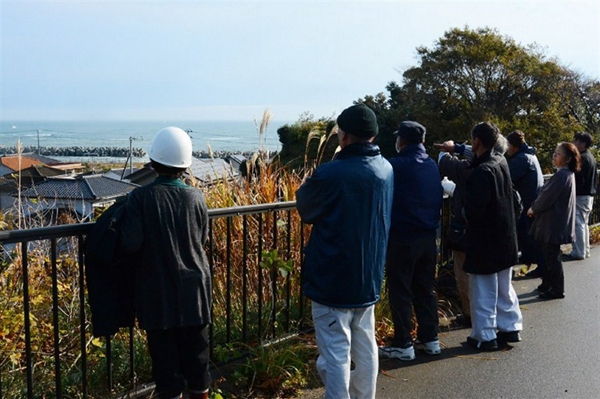
Local
residents look out to sea from higher ground after evacuating their
homes following an 6.9 magnitude earthquake and tsunami alert in Iwaki,
Fukushima prefecture, on November 22, 2016. A powerful 6.9-magnitude
earthquake hit northeastern Japan on November 22, triggering tsunamis
along the coast including a one-metre (3.3-foot) wave that crashed
ashore at the stricken Fukushima nuclear power plant.
A powerful 6.9-magnitude earthquake hit northeast Japan on Tuesday, sparking panic and triggering a tsunami including a one-metre (three-foot) wave that crashed ashore at the stricken Fukushima nuclear power plant.
National broadcaster NHK urged residents to "flee immediately" to higher ground, reminding viewers to heed the lessons of the "Great East Japan Earthquake".
A massive undersea quake with a magnitude of 9.0 that struck in March 2011 unleashed a tsunami that left more than 18,500 people dead or missing. It sent three reactors into meltdown at the Fukushima Daiichi power plant in one of the world's worst nuclear disasters.
An official from plant operator TEPCO told a news conference that a one-metre wave had hit the coast at the facility, but a company spokesman told AFP there were no reports of damage.
About a dozen other waves were recorded elsewhere on the northeast coast, according to the Meterological Agency, but they were smaller than initial warnings of waves as high as 3.0 metres.
The biggest, measuring 1.4 metres, hit the port at Sendai north of Fukushima, but officials said there were no reports of damage there.
NHK aired rolling coverage of the earthquake, with the words "Tsunami! Flee!" in white lettering over a bright red band on the screen.
The Meterological Agency lifted its final tsunami warning nearly seven hours after the earthquake struck.
TEPCO earlier reported that a water cooling system at a reactor in the separate Fukushima Daini facility had briefly stopped, in an automatic response, but that it was back up and operating.
"The biggest risk now is a case whereby contaminated water is carried away with the tsunami, which pollutes the environment," TEPCO's chief decommissioning officer Naohiro Masuda told reporters, of the situation at Fukushima Daiichi.
The 2011 disaster sent radiation levels across the Pacific Ocean soaring and decimated some fishing grounds off Japan's coast.
The global Scientific Committee on Oceanic Research said in July that levels were returning to normal but that the seabed and harbour near Fukushima were still highly contaminated.
Residents along the coast heeding evacuation advice clogged some roads, with a Fukushima newspaper reporting unusual early morning traffic jams in the small city of Soma.
There were no immediate signs of widespread damage and only minor injuries were initially reported.
Fourteen injuries have been reported throughout the region, including three elderly women who broke bones when falling or trying to evacuate.
- 'Ground still shaking' -
Still, people along the coast were badly shaken.
"It was huge and lasted so long," Akemi Anzai, from the city of Minamisoma north of the Fukushima plant, said of the quake.
"The tsunami siren warning can be heard from the coastline," she told AFP. "The ground is still shaking. I'm so scared. But my concern is rather the situation at the nuclear plant."
The United States Geological Survey said the 6.9 magnitude quake, at a shallow depth of 11.3 kilometres (seven miles), struck shortly before 6:00 am (2100 GMT on Monday) in the Pacific off Fukushima.
It shook buildings in Tokyo, 230 kilometres to the south.
Shinkansen bullet train services were suspended in the region but gradually resumed, though delays were still being reported.
Sendai airport, which suffered significant damage during the 2011 tsunami, temporarily closed but flights resumed in the morning.
Fishing boats had rushed out to sea to avoid the direct impact of the tsunami, the Sankei Shimbun said.
NHK showed footage of what appeared to be seawater flowing up a river in Miyagi prefecture though none of it surged beyond the banks.
"The fear that I felt almost six years ago came back," Junko Murata, another Minamisoma resident, told AFP.
"Maybe there won't be major damage this time but we will have to remain on edge for years and years," she added, referring to the Fukushima plant.
Japan sits at the junction of four tectonic plates and suffers several relatively violent quakes every year, although high building standards and frequent drills limit the number of casualties.
In April two strong quakes hit Kumamoto prefecture, leaving at least 50 dead and causing widespread damage.
